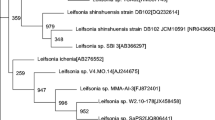Abstract
A strain of Serratia marcescens showing the ability to degrade caffeine and other methylxanthines was isolated from soil under coffee cultivation. Growth was observed only with xanthines methylated at the 7 position (caffeine, 1,3,7-dimethylxanthine; paraxanthine, 1,7-dimethylxanthine; theobromine, 3,7-dimethylxanthine and 7-methylxanthine). Paraxanthine and theobromine were released in liquid medium when caffeine was used as the sole source of carbon and nitrogen. When paraxanthine or theobromine were used, 3-methylxanthine, 7-methylxanthine, and xanthine were detected in the liquid medium. Serratia marcescens did not grow with theophylline (1,3-dimethylxanthine), 1-methylxanthine, and 3-methylxanthine, and poor growth was observed with xanthine. Methyluric acid formation from methylxanthines was tested in cell-free extracts by measuring dehydrogenase reduction of tetrazolium salt in native-polyacrylamide gel electrophoresis gel. Activity was observed for all methylxanthines, even those with which no bacterial growth was observed. Our results suggest that in this strain of S. marcescens caffeine is degraded to theobromine (3,7-dimethylxanthine) and/or paraxanthine (1,7-dimethylxanthine), and subsequently to 7-methylxanthine and xanthine. Methyluric acid formation could not be confirmed.
Similar content being viewed by others
References
Blecher R, Lingens F (1977) The metabolism of caffeine by a Pseudomonas putida strain. Hoppe-Seyler's Z Physiol Chem Bd 358:807–817
Bradford MN (1976) A rapid and sensitive method for the Quantitation of microgram quantities of protein utilizing the principle of protein-dye binding. Anal Biochem 72:248–254
Friedman J, Waller GR (1985) Allelopathy and autotoxicity. TIBS 47–50
Gluck M, Lingens F (1987) Studies on the microbial production of theobromine and heteroxanthine from caffeine. Appl Microbiol Biotechnol 25:334–340
Mimura A, Akimoto T, Kodaira R (1969) Transformation of an organic compound using microorganisms; on the formation of 6,8-dihydroxypurine. J Ferment Technol 47:268–273
Nelson DW Sommres LE (1982) Total carbon, organic carbon, and organic matter. In: Page AL (ed). Methods of soil analysis. Agronomy monograph No. 9, Part 2. Chemical and microbiological properties. American Society of Agronomy and Soil Science Society of America, Madison, Wisconsin, pp 539–579
Rizvi SJH, Mukerji D, Mathur SN (1980) A new report on a possible source of natural herbicide. Indian J Exp Biol 18:777–778
Rizvi SJH, Mukerji D, Mathur SN (1981) Selective phyto-toxicity of 1,3,7-trimethylxanthine between Phaseolus mungo and some weeks. Agric Biol Chem 45:1255–1256
Rouf MA, Lomprey Jr RF (1968) Degradation of uric acid by certain aerobic bacteria. J Bacteriol 96:617–622
Sambrook J, Fritsch EF, Maniatis T (1989) Molecular cloning: a laboratory manual, vol. 1, appendix A, 2nd ed. Cold Spring Harbor Laboratory Press, New York
Schnitzer M (1982) Organic matter characterization. In: Miller RH, Keeney DR (eds), Methods of soil analysis, vol. 9, part 2. Chemical and microbiological properties. American Society of Agronomy and Soil Science Society of America, Madison, Wisconsin, pp 581–594
Starr MP, Grimont PAD, Grimont F, Starr PB (1976) Caprylate-thallous agar medium for selectively isolating Serratia and its utility in the clinical laboratory. J Clin Microbiol 4:270–276
Vallejos CE (1983) Enzyme activity staining. In: Tanksley SD, Orton TJ (ed), Isozymes in plant genetics and breeding, part A. Elsevier Science Publishers Amsterdam, pp 469–516
Waller GR, Kumari D, Friedman J, Friedman N, Chou C-H (1986) Caffeine autotoxicity in Coffea arabica L. In: Putnam AR, Tang C-S (ed), The science of allelopathy. John Wiley & Sons. New York, pp 243–269
Woolfolk CA (1975) Metabolism of N-methylpurines by a Pseudomonas putida strain isolated by enrichment on the caffeine as sole source of carbon and nitrogen. J Bacteriol 123:1088–1106
Author information
Authors and Affiliations
Additional information
Correspondence to: Paulo Mazzafera.
Rights and permissions
About this article
Cite this article
Mazzafera, P., Olsson, O. & Sandberg, G. Degradation of caffeine and related methylxanthines by Serratia marcescens isolated from soil under coffee cultivation. Microb Ecol 31, 199–207 (1996). https://doi.org/10.1007/BF00167865
Received:
Revised:
Published:
Issue Date:
DOI: https://doi.org/10.1007/BF00167865




